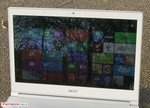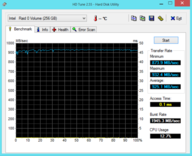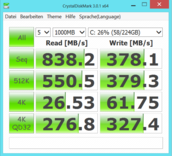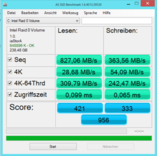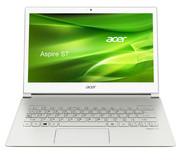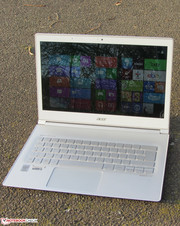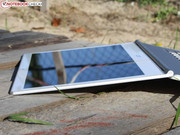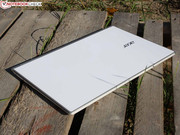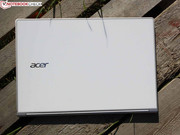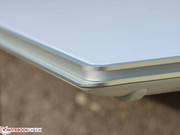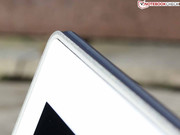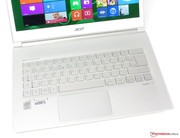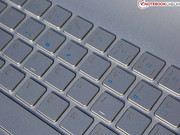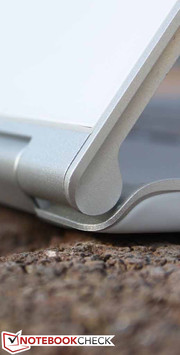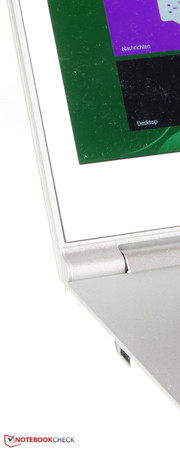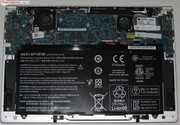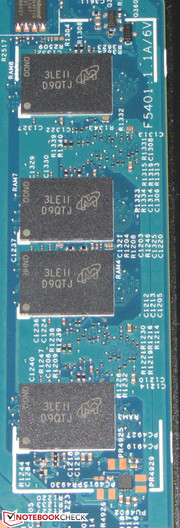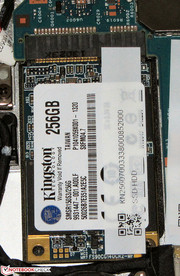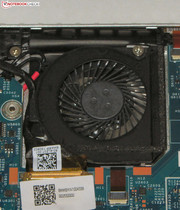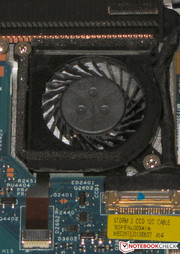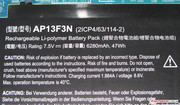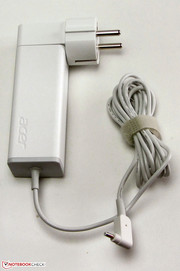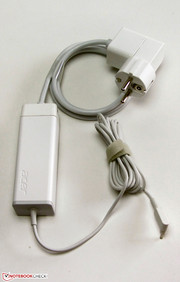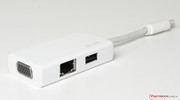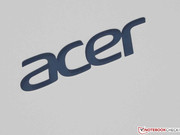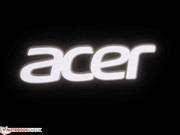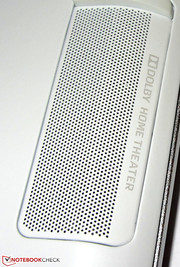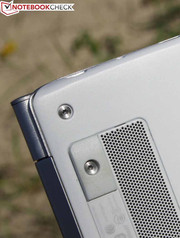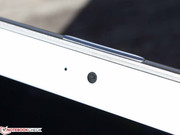Review Acer Aspire S7-392 Ultrabook

For the original German review, see here.
Noble, fast, thin and light - this is a short description of the Aspire S7-392. The ultrabook is made of magnesium and Gorilla Glass and Acer equips the S7 with a high-resolution display (2560x1440 pixels). It is powered by fast components like a Core i7 processor and an SSD RAID 0 system.
The predecessor Aspire S7-391 (Core i7-3517U, HD Graphics 4000) got a good rating (85%) but there were some issues. It had poor battery runtimes and the display brightness was significantly reduced on battery power. At least the runtimes should not be a problem with the Aspire S7-392 anymore: The combination of a Haswell processor and a larger battery should provide battery runtimes that suit the retail price of the notebook. Our review shows if the Aspire S7-392 can beat its predecessor.
We use the rivals Apple MacBook Pro Retina 13 Late 2013 (Core i5-4258U, Iris Graphics 5100) and Asus Zenbook UX301LA (Core i7-4558U, Iris Graphics 5100) for the comparison.
The Aspire S7-392 basically uses the chassis from the Aspire S7-391, so we will only have a brief look at the case, but not at the input devices, the connectivity and the speakers. The according information can be found in the review of the Aspire S7-391.
Case
Both the Aspire S7-392 and the Aspire S7-391 basically use the same case; the only differences are the port layout and the thickness: The S7-392 has a height of 13 mm and is therefore around 1 mm thicker than its predecessor. Reason for this should be the larger battery. The S7-392 also lacks the threads at the bottom of the S7-391, which could be used for an additional battery. The according module of the S7-391 cannot be used anymore because the S7-392 does not have the necessary connector either.
Connectivity
There are some changes in regard to the connectivity. The new Aspire S7-392 does not have the connector for the additional battery of the Aspire S7-391 anymore; the micro HDMI port was replaced by a standard HDMI port and there is also a mini DisplayPort. Acer provided other ports on the S7-391 via adaptor: an Ethernet port via USB 2.0 and a VGA-out via micro HDMI adaptor. The S7-392 only comes with one adaptor, however, it offers three ports: VGA-out, Fast-Ethernet and USB 2.0. This adaptor can be used via DisplayPort. Similar to the predecessor, we really like the port layout of the S7-392: All the ports are at the back of the two sides, while the areas next to the palm rest are not occupied.
Security
Besides a Kensington lock, Acer also equipped the small notebook with a Trusted Platform Module (1.2) and preinstalled its own Theft Shield software. This is supposed to alert the user in case of data theft if you use the notebook with public wireless hotspots.
Accessories
The box of the S7-392 contains a quick-start poster, a quick-start guide, a manual, warranty information and a small notebook bag. The two adaptors of the old S7-391 have been replaced by one. The predecessor was also accompanied by a small mouse, but this is not the case with the S7-392.
Maintenance
The small Aspire does not have a maintenance cover. However, you can still access the components without any problems: Just loosen the 11 torx screws at the bottom and lift the cover; there are no additional plastic clips. We were a bit surprised when we saw that that the notebook uses a standard mSATA Solid State Drive. The system shows a RAID 0 configuration with two 128 GB SSDs. You could replace the SSD with a larger model and you can even clean the two fans. The battery is also replaceable if it is damaged.
Display
While the Aspire S7-391 used a Full HD display, Acer equips the successor with a WQHD IPS panel with a native resolution of 2560x1440 pixels. The display of the Zenbook has similar specs and the MacBook has even more pixels at 2560x1600. We measure a good average brightness of 298.3 cd/m², even though the predecessor was brighter with 361.7 cd/m². Both the Zenbook (358.3 cd/m²) and the MacBook (330 cd/m²) also have brighter panels.
| |||||||||||||||||||||||||
Brightness Distribution: 76 %
Center on Battery: 316 cd/m²
Contrast: 1663:1 (Black: 0.19 cd/m²)
ΔE Color 4.33 | 0.5-29.43 Ø5
ΔE Greyscale 6.05 | 0.57-98 Ø5.3
59% AdobeRGB 1998 (Argyll 1.6.3 3D)
65.4% AdobeRGB 1998 (Argyll 2.2.0 3D)
92.6% sRGB (Argyll 2.2.0 3D)
64.4% Display P3 (Argyll 2.2.0 3D)
Gamma: 2.41
Contrast (1663:1) and black value (0.19 cd/m²) of the screen are excellent. The results are between the Zenbook (2138:1, 0.196 cd/m²) and MacBook (900:1, 0.4 cd/m²), but the Aspire S7-392 is clearly superior to its predecessor (497:1, 0.734 cd/m²). Neither AdobeRGB nor sRGB can be completely covered by the screen with 59% (AdobeRGB) and 80.4% (sRGB) respectively. These color spaces are important for professional picture editing, for instance.
The color accuracy is quite good out of the box with an average DeltaE 2000 deviation of 4.33 but the trained eye can see a slight blue cast. A calibration improves the DeltaE 2000 deviation to 3.6 and can also reduce the slight blue cast.
The panel of the Aspire is bright enough and has a high contrast, but it is still tricky to use the notebook outdoors. The problem is the glossy display surface, as you can see in our picture that was taken under direct sunlight. You should use the device in the shade if possible. Contrary to the Aspire S7-931, you can use the maximum display brightness of the S7-392 on battery power.
Thanks to the IPS panel you can see the display content even under extreme viewing angles. Acer specifies the viewing angle with 160 degrees and we can support this claim. After you exceed this angle, gray and white colors will start to mix, but the content is still visible.
Performance
Acer's Aspire S7-series notebooks are light and thin ultrabooks that are made of high-quality materials. The Aspire S7-392 has a 13.3-inch form factor, but you can also get the smaller 11.6-inch models from the S7-19x-series. All notebooks offer sufficient performance for daily tasks, however, they are not designed for video games or video editing. Our review unit is currently available for around 1,500 Euros (~$2064), but there is also another configuration at the time of writing: The Acer Aspire Pro S7-392-54208G25tws is basically identical to our review unit, but there are some differences: The Aspire Pro uses a Core i5-4200U processor and Windows 8 Professional; it is also more expensive at around 1,850 Euros (~$2545).
Processor
Inside the thin case of the Aspire is an Intel Core i7-4500U dual-core processor, which is based on Intel's latest Haswell architecture. It has a nominal clock of 1.8 GHz that can be raised up to 2.7 GHz (both cores) and 3 GHz (one core) via Turbo Boost. The CPU also supports Hyper Threading. We are dealing with a ULV CPU that runs with a lower voltage and therefore consumes less energy. Intel specifies the TDP of the Core i7 with 15 Watts.
We can see a CPU clock 2.7 GHz in the single thread tests; the full 3 GHz is only reached occasionally. Multi-thread tests result in a clock of 2.5 GHz for the two cores. The Zenbook (Core i7-4558U, Iris Graphics 5100) shows better results in all scenarios. The processor runs with higher clocks and can also use its maximum Turbo potential during multi-threaded applications. It is also surprising at first that the MacBook (Core i5-4258U, Iris Graphics 5100) shows better results as well, since it uses a Core i5 processor with a 100 MHz lower clock compared to the i7 from the Aspire. However, the Core i5 can maintain the maximum clock of 2.9 GHz and is therefore faster than the Core i7. The MacBook and the Zenbook use the same GPU, which is clearly superior to its counterpart inside the Aspire. Both devices are accordingly faster in the GL benchmarks.
The CPUs (including the integrated GPUs) of the MacBook and the Zenbook are more powerful compared to the Aspire, but they also need more energy in return. Both competitors have processors with a specified TDP of 28 Watts.
System Performance
We cannot criticize the system performance of our review unit. The system is snappy and applications as well as Windows start very quickly. This is also a result of the fast RAID 0 SSD. The notebook gets virtually the same score as its predecessor, however, the Aspire cannot keep up with the results of the MacBook (Core i5-4258U, Iris Graphics 5100) and the Zenbook (Core i7-4558U, Iris Graphics 5100), since both notebooks have better CPUs and GPUs.
| PCMark Vantage Result | 11733 points | |
| PCMark 7 Score | 4970 points | |
| PCMark 8 Home Score Accelerated | 2744 points | |
| PCMark 8 Creative Score Accelerated | 2962 points | |
| PCMark 8 Work Score Accelerated | 3968 points | |
Help | ||
| PCMark 7 - Score (sort by value) | |
| Acer Aspire S7-392 | |
| Samsung ATIV Book 9 Lite 905S3G-K01DE | |
| Sony Vaio Pro 13 SVP-1321C5ER | |
| Samsung ATIV Book 9 Plus | |
| Acer Aspire S7 391-73514G25aws | |
| Apple MacBook Pro Retina 13 inch 2013-10 | |
| Asus Zenbook UX301 | |
Storage Devices
Similar to the Aspire S7-391, Acer equips the S7-392 with a RAID 0 SSD that consists of two 128 GB Solid State Drives. However, both SSDs are on one mSATA module. The resulting capacity is 256 GB and the operating system only shows one drive. Data is divided across both drives, which increases the read and write performances noticeably. But the problem with this solution is that you will lose all your data if only one drive is damaged.
The RAID system of the S7-392 is slower than the counterpart from its predecessor. While the sequential reading performance only shows a small difference, we can see almost twice the writing speeds from the old S7-391. This is, however, not really perceptible in practice. Both the storage solutions of the MacBook (SSD) and the Zenbook (RAID 0) are much better in terms of writing performance, but cannot keep up in regard to reading speeds. Current 2.5-inch SSDs like Samsung's 840 Pro provide faster write speeds than the RAID system of the Aspire, but also cannot keep up in terms of reading performance.
| AS SSD - Seq Read (sort by value) | |
| Acer Aspire S7-392 | |
| SCHENKER XMG C703 | |
| Dell XPS 15 (Late 2013) | |
| Dell Latitude E7440 | |
| Deviltech Fire DT14 | |
| Lenovo ThinkPad X240 | |
| Asus Zenbook UX301 | |
| Apple MacBook Pro Retina 13 inch 2013-10 | |
| Acer Aspire S7 391-73514G25aws | |
| Nexoc B509II Ultra | |
| AS SSD - Seq Write (sort by value) | |
| Acer Aspire S7-392 | |
| Lenovo ThinkPad X240 | |
| Dell Latitude E7440 | |
| Dell XPS 15 (Late 2013) | |
| SCHENKER XMG C703 | |
| Deviltech Fire DT14 | |
| Asus Zenbook UX301 | |
| Apple MacBook Pro Retina 13 inch 2013-10 | |
| Acer Aspire S7 391-73514G25aws | |
| Nexoc B509II Ultra | |
Graphics
Graphics are handled by the Intel HD Graphics 4400. The GPU supports DirectX 11.1 and has a clock between 200 and 1,100 MHz. All 3DMark benchmark results of the Aspire are lower compared to the MacBook (Core i5-4258U, Iris Graphics 5100) and the Zenbook (Core i7-4558U, Iris Graphics 5100). This is not surprising, since both devices have a much more powerful Intel GPU. Despite the identical CPU in the two notebooks, we can see better results from the Zenbook. But the explanation is quite simple; the GPU of the Zenbook just has a slightly higher clock.
| 3DMark 06 Standard Score | 5609 points | |
| 3DMark Vantage P Result | 4027 points | |
| 3DMark 11 Performance | 925 points | |
| 3DMark Ice Storm Standard Score | 28849 points | |
| 3DMark Cloud Gate Standard Score | 4119 points | |
| 3DMark Fire Strike Score | 583 points | |
Help | ||
| Acer Aspire S7-392 HD Graphics 4400, 4500U, 2x Kingston SMSR150S3256G (RAID 0) | Asus Zenbook UX301 Iris Graphics 5100, 4558U, 2x Sandisk X110 SD6SP1M-128G RAID 0 | Apple MacBook Pro Retina 13 inch 2013-10 Iris Graphics 5100, 4258U, Apple SSD SM0256F | |
|---|---|---|---|
| 3DMark | 45% | 38% | |
| 1280x720 Ice Storm Standard Score | 28849 | 41524 44% | 39510 37% |
| 1280x720 Cloud Gate Standard Score | 4119 | 5518 34% | 5286 28% |
| 1920x1080 Fire Strike Score | 583 | 918 57% | 863 48% |
Gaming Performance
Even though gaming is not a core aspect for the Aspire, you can still play some titles. The notebook is usually powerful enough to run most of the current games in low resolutions and with low quality settings. Less complex games can even be played in higher resolutions and settings - for example several titles from the FIFA-series. Similar to the 3DMark results, both the MacBook and the Zenbook are more powerful and produce higher frame rates. If occasional gaming is important for you, you might want to consider one of these devices.
| low | med. | high | ultra | |
| The Elder Scrolls V: Skyrim (2011) | 33.2 | 17.2 | 10.6 | |
| Anno 2070 (2011) | 60.6 | 28.9 | 17.4 | |
| Tomb Raider (2013) | 47.6 | 24.4 | 14.9 |
| Acer Aspire S7-392 HD Graphics 4400, 4500U, 2x Kingston SMSR150S3256G (RAID 0) | Asus Zenbook UX301 Iris Graphics 5100, 4558U, 2x Sandisk X110 SD6SP1M-128G RAID 0 | Apple MacBook Pro Retina 13 inch 2013-10 Iris Graphics 5100, 4258U, Apple SSD SM0256F | |
|---|---|---|---|
| Tomb Raider | 36% | 34% | |
| 1024x768 Low Preset | 47.6 | 61.3 29% | 64.4 35% |
| 1366x768 Normal Preset AA:FX AF:4x | 24.4 | 34.5 41% | 32.8 34% |
| 1366x768 High Preset AA:FX AF:8x | 14.9 | 20.7 39% | 19.7 32% |
Emissions
System Noise
The fan of the Aspire doesn't even run during idle and we measure a system noise of 29.6 dB(A). Both rivals are on a similar level: MacBook (27.4 dB(A)) and Zenbook (29.6 up to 31.3 dB(A)). Medium workloads (3DMark06 running) and maximum load (stress test, Prime95 and Furmark simultaneously) results in a slight increase to 33.5 and 33.8 dB(A) respectively. The value under maximum load is basically identical because neither the GPU nor the CPU can maintain their clocks (CPU: 1.1 up to 1.2 GHz; GPU: 800 - 850 MHz). The results of the Zenbook are higher (38.7 and 39.1 dB(A)), despite the CPU throttling to 1.2 GHz under load, and the MacBook is even louder with 42.5 and 44.7 dB(A). Both notebooks require more cooling because of their 28 Watts CPUs, while the CPU of the Acer is more frugal with a TDP of 15 Watts. We can see a noticeable improvement over the predecessor, but the S7-391 did not have problems with throttling under load. The Aspire S7-392 produces some kind of electronic whistle when we access the drive.
Noise Level
| Idle |
| 29.6 / 29.6 / 29.6 dB(A) |
| Load |
| 33.5 / 33.8 dB(A) |
 | ||
30 dB silent 40 dB(A) audible 50 dB(A) loud |
||
min: | ||
Temperature
All three competitors keep cool during idle and their surface temperatures are very low. We can only see a moderate temperature rise under load. Both the MacBook and the Aspire exceed 40 °C around the fan exhaust while the Zenbook even reaches more than 50 °C.
Our stress test (Prime95 and Furmark simultaneously for at least one hour) results in a CPU clock of 1.1 up to 1.2 GHz while the GPU manages 800 up to 850 MHz, both with the PSU attached and on battery power. The stress test is an extreme scenario and is not relevant in practice. Our benchmarks showed that you can use the full performance of the components during everyday tasks. We also ran 3DMark06 after the stress test, and the result was identical to the cold run. We therefore do not expect performance issues with high temperatures. The CPU temperature leveled off at around 73 °C (PSU attached).
(±) The maximum temperature on the upper side is 41.3 °C / 106 F, compared to the average of 35.9 °C / 97 F, ranging from 21.4 to 59 °C for the class Subnotebook.
(-) The bottom heats up to a maximum of 46.8 °C / 116 F, compared to the average of 39.4 °C / 103 F
(+) In idle usage, the average temperature for the upper side is 25.3 °C / 78 F, compared to the device average of 30.7 °C / 87 F.
(+) The palmrests and touchpad are cooler than skin temperature with a maximum of 30.1 °C / 86.2 F and are therefore cool to the touch.
(±) The average temperature of the palmrest area of similar devices was 28.3 °C / 82.9 F (-1.8 °C / -3.3 F).
Energy Management
Power Consumption
The energy consumption of the Aspire during idle is quite low with 4.2 up to 7.6 Watts and the same applies for the MacBook (2.8 up to 9 Watts) as well as the Zenbook (4.5 up to 7.5 Watts). Medium load (3DMark06 running) and maximum load (stress test, Prime95 and Furmark simultaneously) result in 27.5 and 25.8 Watts for the Aspire. The second value is lower because both the CPU and GPU are throttled under maximum load. The MacBook (58 and 60.6 Watts) and Zenbook (52.2 and 45.5 Watts) have more powerful components and consume more energy. The Zenbook also has throttling issues under load, so the consumption is accordingly lower.
| Off / Standby | |
| Idle | |
| Load |
|
Battery Runtime
The Aspire manages an idle runtime of 12:14 hours. This is much better than the Zenbook (8:56 h), but it cannot keep up with the excellent runtime of the MacBook (25:35 h). The idle runtime is simulated by the Battery Eater Reader's Test that uses minimum display brightness and energy-saving features while all wireless connections are deactivated. You can use the Aspire for 1:56 hours under load, while both the MacBook (1:39 h) and the Zenbook (0:55 h) have to be recharged sooner. The load runtime is determined by the Battery Eater Classic Test, which uses the maximum display brightness and the high-performance energy profile while all wireless connections are activated.
Our WLAN test is finished after 6:10 hours. The Zenbook (6:25 h) runs 15 minutes longer while the MacBook (9:29 h) is once again much better than the rivals. This test uses a script that refreshes a website every 40 seconds. The energy-saving features are active and the display brightness is adjusted to around 150 cd/m².
We use the familiar Big Buck Bunny video (H.264, 1920x1080 pixels) in a loop to determine the runtime during movie playback. All wireless modules are deactivated and we adjusted the display brightness to 150 cd/m². The Aspire manages a good runtime of 5:58 hours with the adjusted brightness and a still reasonable 5:00 hours with maximum brightness. The MacBook ran 7:47 hours but we have no results for the Zenbook.
Acer basically managed to double the runtimes of the S7-392 compared to its predecessor, which is a result of the low consumption during idle and the larger battery. It is not really surprising that the MacBook manages the best runtimes since it has the largest battery (Acer: 47 Wh, Apple: 71.8 Wh, Asus: 50 Wh).
Verdict
The Acer Aspire S7-392 is a refreshed version of the old Aspire S7-391. Acer did update some components (processor, screen) and improved some drawbacks (battery runtimes, system noise, temperatures). This is enough to transform a good ultrabook into a very good ultrabook. The S7-392 offers very good application performance and is always quiet. It does not consume very much energy and manages good battery runtimes, but the additional battery of the predecessor is not available anymore. The display of the S7-392 is not as bright as the predecessor but it is still sufficient. It also has a better contrast in return and, most importantly, the IPS panel of the S7-392 has a higher resolution (2560x1440 pixels).
Apple's MacBook Pro Retina 13 Late 2013 and Asus' Zenbook UX301L are interesting alternatives if you need more CPU and GPU performance. They have the more powerful components but consume more energy in return. The MacBook also offers the best battery runtimes.


 Deutsch
Deutsch English
English Español
Español Français
Français Italiano
Italiano Nederlands
Nederlands Polski
Polski Português
Português Русский
Русский Türkçe
Türkçe Svenska
Svenska Chinese
Chinese Magyar
Magyar









